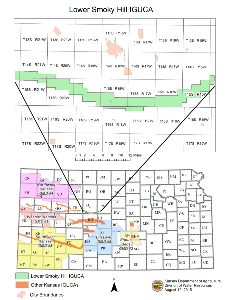
To address declining groundwater levels in Smoky Hill River alluvium the chief engineer initiated IGUCA proceedings on November 30, 1983. A public hearing was held on February 23 and 24 of 1984. The IGUCA order was issued on May 31, 1984, a correctional order was issued July 27, 1984 and a supplemental order on January 23, 1987.
Pursuant to
K.A.R. 5-20-2, each of the eight IGUCA orders in place before July 1, 2008 must be reviewed in a process that includes a public hearing conducted by the chief engineer. While a brief summary of the Lower Smoky Hill IGUCA has been provided below, the IGUCA order is also available and should be referred to for detailed conclusions and provisions.
November 30, 1983: IGUCA initiated
- Conditions existed in the groundwater alluvium which required regulation in the public interest
February 23 and 24, 1984: Public hearing
May 31, 1984: IGUCA Order issued
- Closed the area to new appropriations
- Required installation of water flowmeters
- Required water use reporting
- Restricted appropriated irrigation water use
- Average 15 acre-inches per acre on maximum authorized acres (base period of 1977 to 1982)
- Restricted all other appropriations and water uses
- Calendar year 1984: 95% of maximum usage for any one of the calendar years 1981, 1982 and 1983
- Calendar year 1985 and later: 90% of maximum usage between 1981 and 1983
- Usage not to exceed authorized quantity
- Appointed a task force
- Initiated proceedings to extend the boundaries to include the alluvium of the Smoky Hill River Valley and its major tributaries
July 27, 1984: Correction Order issued
- Corrected an error in townships listing
January 23, 1987: Supplemental Order issued
- Extended the IGUCA to include portions of Gove County
The May 31, 1984 IGUCA Order established a task force to further study the water supply and demand and make recommendations to the chief engineer. The task force was also specifically charged with providing advice and recommendations on plans and alternatives for bringing the stream-aquifer system into balance between water supply and demand. This included but was not limited to possible changes to the operation and/or use of water stored in Cedar Bluff Reservoir, limitations on withdrawal o water from the area, alternative sources of water for use by existing water users in the area, conservation plans for water use in the area, and other items that were deemed necessary to effectuate a long term solution to the water supply problem in the area.
The task force consisted of one representative from each of the groups below:
- Board of directors of the Conservation Districts of Ellis, Trego, Rush and Russell Counties
- Boards of directors of any of the rural water districts within the area
- City of Hays
- City of Russell
- Holders of water rights or approved applications for permit to appropriate groundwater for irrigation use within the control area
- Cedar Bluff Irrigation District
- Domestic water users within the control area
- Kansas Water Office
- Kansas Geological Survey
- U.S. Bureau of Reclamation
- Kansas Water Authority
The task force met nine times with each representative presenting report on their area of expertise. The task force reviewed all reports, followed by brainstorming sessions to produce a list of ideas as potential recommendations. The task force adopted a set of recommendations and submitted to the chief engineer November 1985:
- Utilize the KGS water management model to manage the water and to cooperate with KWO and KGS in refining the model for use in basin and state-wide planning
- Investigate the possibility of establishing a minimum by-pass of flows origination above Cedar Bluff Dam and the minimum bypass is subject to agreements with those holding the storage rights
- Water users to file water conservation plans
- City of Hays should develop and alternate source of supply to reduce the draft on the Smoky Hill Basin
- Reduce water use allocations for all water users except domestic (share the shortage by all users)
- Extend the boundaries of the IGUCA to include the high terraces adjacent to the alluvium
- Abandon domestic rights that are now Rural Water District No. 1 and transfer the amount of water to a new appropriation for the rural water district
- Request Legislature for funds for research and development of the Dakota Formation
- Increase awareness of the pollution problems especially related to the production and storage of petroleum products
- Cooperate with KSU Extension Service and other agencies to develop and implement water education programs
- Endorsed the proceedings to extend the boundaries above Cedar Bluff Dam and to expedite the proceedings
- Continue to use the Smoky Hill Task Force as an advisory committee
- Other items were discussed and no action taken but were included in the report as a matter of information to the chief engineer
Individuals who have questions regarding the Lower Smoky Hill IGUCA should contact David Engelhaupt at
David.Engelhaupt@ks.gov for more information.